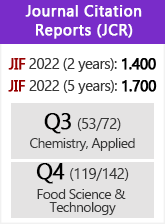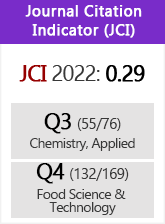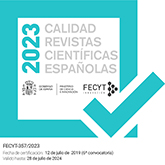Major components in oils obtained from Amazonian palm fruits
DOI:
https://doi.org/10.3989/gya.023513Keywords:
Amazonian, Fatty acids, Palm fruits, Triacylglycerols, Vegetable oilsAbstract
Native palm trees belong to the Arecaceae family and are among the most useful plant resources in the Amazons. Despite its great diversity and various uses, few species have been study in detail, which makes it necessary to perform more comprehensive studies on the quality and composition of species not yet explored. This study deals with the characterization of the major compounds in the oils obtained from the mesocarp of fruits of the main palm species from the State of Amapá, Brasil, i.e. bacaba (Oenocarpus bacaba), buriti (Mauritia flexuosa), inajá (Maximiliana maripa), pupunha (Bactris gasipaes) and tucumã (Astrocaryum vulgare). Physicochemical characteristics, fatty acids and triacylglycerol (TAG) contents were analyzed by HPLC and GC. The proximate composition of the fruits was also analyzed. The results relating to acidity, peroxide value and polar compounds indicate good quality of the oils obtained. Oleic acid ranging from 39.2 to 71.6% and palmitic acid ranging from 20.8 to 39.6% were the two major fatty acids in all the samples. The oils from inajá were characterized by the presence of significant amounts of lauric (4.6%) and miristic (10.7%) acids while in bacaba, buriti, pupunha and tucumã, as in most edible vegetable oils, only the fatty acids of 16 and 18 carbon atoms were present. Accordingly, the major TAG species in all the samples were POP, POO and OOO. The mesocarp of the palm fruit had a high content in lipids ranging from 17.0% for pupunha to 38.3% for bacaba, expressed as dry basis.
Downloads
References
AENOR. 1991. Asociación Espa-ola de Normalización, Catálogo de Normas UNE, Madrid.
Antoniosi-Filho NR, Mendes OL, Lanças FM. 1995. Computer prediction of triacylglycerol composition of vegetable oils by HRGC. Chromatographia 40, 557-562. http://dx.doi.org/10.1007/BF02290268
AOCS. 1997. Method Cd 12b-92 in Official methods and recommended practices of the American Oil Chemists' Society, 5th ed., AOCS, Champaign.
Bereau D, Benjelloun-Mlayah B, Banoub J, Bravo R. 2003. FA and unsaponifiable composition of five Amazonian palm kernel oils. J. Am. Oil Chem. Soc. 80, 49-53. http://dx.doi.org/10.1007/s11746-003-0649-5
Carelli AA, Cert A. 1993. Comparative study of the determination of triacylglycerols in vegetable oils using chromatographic techniques. J. Chromatogr. 630, 213-222. http://dx.doi.org/10.1016/0021-9673(93)80458-K
Clement CR, Lleras Pérez E, Van Leeuwen J. 2005. O potencial das palmeiras tropicais no Brasil: acertos e fracassos das últimas décadas. Agrociências 9, 67-71.
Escriche I, Restrepo J, Serra JA, Herrera LF. 1999. Composition and nutritive value of Amazonian palm fruits. Food Nutr. Bull. 20, 361-365.
Fernández-Moya V, Martínez-Force E; Garces R. 2000. Identification of triacylglycerol species from highsaturated sunflower (Helianthus annuus) mutants. J. Agric. Food Chem. 48, 764-769. http://dx.doi.org/10.1021/jf9903861 PMid:10725146
IUPAC. 1992a. Standard Method 2.301. Preparation of the fatty acid methyl esters. In Standard methods for the analysis of oils, fats and derivatives, 7th ed. International Union of Pure and Applied Chemistry, Blackwell Scientific: Oxford, UK.
IUPAC. 1992b. Standard Method 2.302. Gas-liquid chromatography of fatty acid methyl esters. In Standard methods for the analysis of oils, fats and derivatives, 7th ed. International Union of Pure and Applied Chemistry, Blackwell Scientific: Oxford, UK.
IUPAC. 1992c. Standard Method 2.507. Determination of polar compounds in frying fats 2.507 In Standard Methods for the Analysis of Oils, Fats and Derivatives, 7th ed.; International Union of Pure and Applied Chemistry, Blackwell Scientific: Oxford, UK, 1992.
Lumley ID. 1998. Polar compounds in heated oils. In Frying of Foods. Principles, Changes, New Approaches. Varela G, Bender AE, Morton ID (eds) Ellis Harwood Ltd. Chichester, England.
Mambrin MCT, Barrera-Arellano D. 1997. Caracterización de aceites de frutos de palmeras de la región amazónica del Brasil. Grasas Aceites 48, 154-158. http://dx.doi.org/10.3989/gya.1997.v48.i3.783
Montúfar R, Laffargue A, Pintaud J, Hamon S, Avallone S, Dussert S. 2010. Oenocarpus bataua Mart. (Arecaceae): rediscovering a source of high oleic vegetable oil from Amazonia. J. Am. Oil Chem. Soc. 87, 167-172. http://dx.doi.org/10.1007/s11746-009-1490-4
Moreda W, Pérez-Camino MC, Cert A. 2003. Improved method for the determination of triacylglycerols in olive oils by high performance liquid chromatography. Grasas Aceites. 54, 175-179. http://dx.doi.org/10.3989/gya.2003.v54.i2.262
Rodrigues AMC, Darnet S, Silva LHM. 2010. Fatty Acid profiles tocopherol of buriti (Mauritia flexuosa), patawa (Oenocarpus bataua), tucumã (Astrocaryum vulgare), mari (Poraqueiba paraensis) and inajá (Maximiliana maripa) fruits. J. Braz. Chem. Soc. 21, 2000-2004. http://dx.doi.org/10.1590/S0103-50532010001000028
Rosso VV, Mercadante AZ. 2007. Identification and quantification of carotenoides, by HPLC-PDA-MS/ MS, from Amazonian fruits. J. Agric. Food Chem. 55, 5062-5072. http://dx.doi.org/10.1021/jf0705421 PMid:17530774
Saraiva S A, Cabral EC, Eberlin MN, Catharino RR. 2009. Amazonian vegetable oils and fats: fast typification and quality control via triacylglycerol (TAG) profiles from dry matrix-assisted laser desorption/ionization time-of-flight (MALDI-TOF) mass spectrometry fingerprinting. J. Agric. Food Chem. 57, 4030-4034. http://dx.doi.org/10.1021/jf900043u PMid:19358529
Vásquez-Ocnín, P. G., Alvarado, L. F., Solís, V. C., Torres, R. P. and Mancini-Filho, J. 2010. Chemical characterization and oxidative stability of the oils from three morphotypes of Mauritia flexuosa L. f, from the Peruvian Amazon. Grasas Aceites 61, 390-397. http://dx.doi.org/10.3989/gya.010110
Yuyama LKO, Aguiar JPL, Yuyama K, Clement CR, Macedo SHM, Fávaro DIT, Afonso C, Vasconcellos MBA, Pimentel SA, Badolato ESG, Vannucchi, H. 2003. Chemical composition of the fruit mesocarp of three peach palm (Bactris gasipaes) populations grown in central Amazonia, Brazil. Int. J. Food Sci. Nutr. 54, 49-56. PMid:12701237
Downloads
Published
How to Cite
Issue
Section
License
Copyright (c) 2013 Consejo Superior de Investigaciones Científicas (CSIC)

This work is licensed under a Creative Commons Attribution 4.0 International License.
© CSIC. Manuscripts published in both the printed and online versions of this Journal are the property of Consejo Superior de Investigaciones Científicas, and quoting this source is a requirement for any partial or full reproduction.All contents of this electronic edition, except where otherwise noted, are distributed under a “Creative Commons Attribution 4.0 International” (CC BY 4.0) License. You may read here the basic information and the legal text of the license. The indication of the CC BY 4.0 License must be expressly stated in this way when necessary.
Self-archiving in repositories, personal webpages or similar, of any version other than the published by the Editor, is not allowed.
















